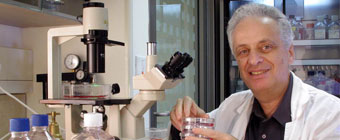New Semaphorin Molecules & Targets for the treatment of Cancer and AMD
Since tumor progression depends on angiogenesis, Prof. Neufeld demonstration that class-3 semaphorins function as anti-angiogenic factors suggested that these semaphorins have the potential to function as natural anti-tumorigenic drugs.
Vascular endothelial growth factor (VEGF) is a major angiogenic factor that is synthesized in several alternatively spliced forms. Professor Gera Neufeld, a member of the Rappaport Family Institute for Research in the Medical Sciences, Haifa, Israel, studies tumor angiogenesis and investigates the molecular mechanisms that contribute to the development and progression of cancer.
Prof. Neufeld hypothesized that receptors that recognize only specific splice forms of VEGF may exist. Such receptors were initially identified by Prof. Neufeld in binding/crosslinking experiments, and were later identified as the products of the two neuropilin genes in work that was done in collaboration with the group of Dr. Michael Klagsbrun from the HarvardMedicalSchool, Boston, USA. Neuropilins were already known as receptors for members of the class-3 semaphorin family of axon guidance factors, and these observations suggested that semaphorins could also be regulators of angiogenesis.
Prof. Neufeld was the first to demonstrate that class-3 semaphorins function as anti-angiogenic factors. Since tumor progression depends on angiogenesis, these experiments suggested that these semaphorins have the potential to function as natural anti-tumorigenic drugs. In order to transduce semaphorin signals, neuropilins form complexes with receptors belonging to the plexin receptor family. The laboratory is currently investigating the role of the different semaphorins and plexins in angiogenesis and in tumor progression, and has recently identified the plexin-A4 receptor as a receptor that plays an important role in tumor progression.
In addition, research done in the laboratory of Prof. Neufeld has identified LOXL2, a member of the lysyl-oxidase family of extracellular matrix modifying enzymes, as an enzyme, which is up-regulated in metastatic tumor cells. This research also showed that Loxl2 promotes the invasiveness of tumor cells and induces tumor fibrosis. These findings suggest that Loxl2 could be a potential target for anti-tumorigenic and anti-fibrotic drugs. Based upon these findings, a drug that targets LOXL2 was recently developed by Arresto Biosciences (recently acquired by Gilead Sciences Inc.). This drug (Simtuzumab) is currently being tested in clinical trials. Current research on lysyl-oxidases in Prof. Neufeld's laboratory is focused on the characterization of the molecular mechanisms by which LOXL2 promotes tumor invasiveness and fibrosis, and Prof. Neufeld has recently identified the product of the gene encoding Receptor Activity Modifying Protein-3 (RAMP3) as an important mediator of LOXL2 activity.
Commercial Opportunities
|
Target / Molecule |
Commercialization Status |
Link to molecule description |
|
LOXL2 |
Licensed |
|
|
UNCL-Semaphorin3E for cancer and AMD treatment |
Available for Licensing |
|
| UNCL-Semaphorin3C for the treatment of lymphangiogenic disorders | Available for Licensing | Read more |
Related Links:








